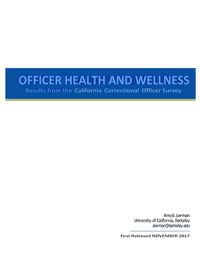Officer Health and Wellness: Results from the California Correctional Officer Survey

Abstract
In just four decades, the size of the U.S. state prison population grew by more than 700 percent. By 2008, the number of incarcerated individuals in the United States hit an all-time high, with 1 in 100 adults in either prison or jail and fully 1 in every 31 American adults under some form of correctional jurisdiction (including incarceration, probation, and parole).
Researchers have noted these patterns and trends with alarm. Yet while expansive studies have been conducted on correctional systems in the United States, most of this work begins and ends with a focus on the incarcerated. Much of the early literature either ignores correctional personnel altogether, or paints an overly simplistic picture. While interest in those who work inside American prisons has begun to grow, we still know surprisingly little about what happens to correctional personnel as a function of spending a career inside the prison system.
Like the number of people incarcerated, the ranks of people employed by the U.S. criminal justice system have increased substantially. As of 2003, almost 13 percent of all public employees (and a larger percentage in 15 states and the District of Columbia) worked in the criminal justice sector. Corrections alone accounts for more than 63 percent of state criminal justice employees, with police protection and judicial/legal employees accounting for the other 14 and 22 percent, respectively. In recent years, the correctional system has employed more people than General Motors, Ford, and Wal-Mart combined.
On the front lines of the prison system, correctional officers, perhaps more than anyone else, directly affect the practice of incarceration in the way that they perform their jobs. Because of this, correctional programs and policies can have little chance of success without their overall health. This is particularly important when considering the mission of the California Department of Corrections and Rehabilitation (CDCR) and its goals of promoting public safety through a professional staff, as well as a constructive correctional and rehabilitation environment. Understanding that correctional work can negatively impact the well-being of both inmates and correctional officers, the California Correctional Peace Officers Association (CCPOA), the CCPOA Benefit Trust Fund (BTF), and the California Department of Corrections and Rehabilitation (CDCR) have joined forces with researchers at the University of California, Berkeley (UCB) to address the issues of law enforcement health and wellness.
As a starting point, Dr. Amy E. Lerman and her team at UCB developed the California Correctional Officer Survey (CCOS). The CCOS is a large-scale effort to gather individual-level information on the thoughts, attitudes, and experiences of criminal justice personnel. The CCOS was first conducted in 2006, and the instrument was then expanded and replicated from March to May of 2017. The most recent survey includes a sample of 8,334 officers and other sworn staff, providing a vast cross-section of officers across all of California’s correctional institutions and parole offices.
This report summarizes the results of the CCOS across a set of broad but related categories: mental and physical wellness; exposure to violence; attitudes towards rehabilitation and punishment; job training and management; work-life balance; and training and support.


 Master of Public Policy
Master of Public Policy
 Master of Public Affairs
Master of Public Affairs
 Master of Development Practice
Master of Development Practice
 Doctoral Program
Doctoral Program
 Global and Executive Programs
Global and Executive Programs
 Undergraduate Programs
Undergraduate Programs

 Diversity, Equity, Inclusion
Diversity, Equity, Inclusion
 Student Groups
Student Groups
 Alumni
Alumni
 Directories
Directories

 Faculty
Faculty
 Publications
Publications
 Working Papers
Working Papers
 Centers
Centers
 News Center
News Center
 Policy Initiatives
Policy Initiatives

 For Students
For Students
 For Employers
For Employers
 Career Events
Career Events
 Employment Statistics
Employment Statistics
 Client-based Projects
Client-based Projects
 About GSPP
About GSPP
 Events
Events
 Make a Gift
Make a Gift
 Find a Program
Find a Program
 Find a Faculty Member
Find a Faculty Member
 Find a Center
Find a Center